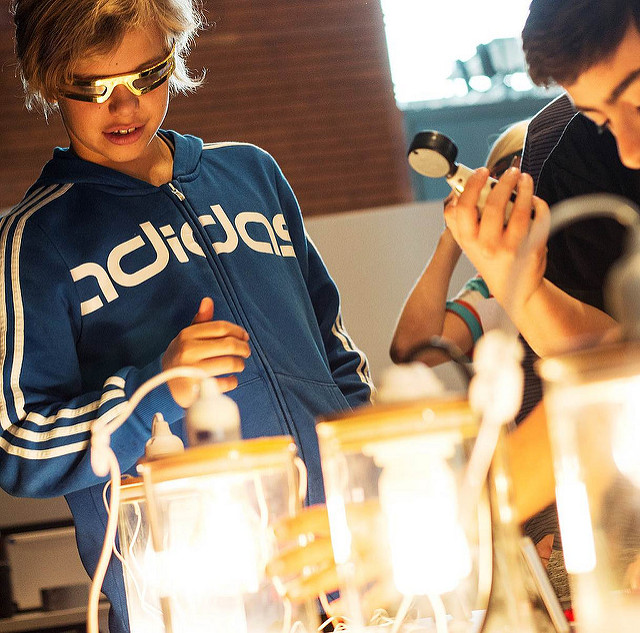In 2015 Researchers’ Night events were run in 26 cities across Sweden by universities, science centres, museums, libraries, municipalities and regional development councils, often working in partnership.
The success of Researchers’ Night in Sweden is due to the dedication of these local organisers who develop exciting programmes in conjunction with dedicated researchers. The 2015 activities reached over 23,300 visitors and involved some 442 researchers.
Here is a taster of some of the hundreds of activities that took place across Sweden on 25 September 2015:
Exhibitions / research stations
Many of the cities organised exhibition areas with research stations and researchers on hand to talk about their work, answer questions and help out with hands-on activities and experiments:
Hands-on activities
In Blekinge, activities that proved particularly popular were making slime, trying to draw with 3D pens, flying drones, racing boats, programming lego robots and trying out virtual reality.
In Skellefteå, 3D printing, computer games, building towers using spaghetti and learning about climate smart food were some of the activities on offer.
In Karlstad, activities were based around the theme of ‘light’. Visitors could control a laser beam and see how it can work as an energy source, see how colour is perceived under different types of lighting and try taking and developing photographs with a box camera.
In Eskilstuna, researchers helped pupils to design and create their own invention at a building workshop and, in Skövde, visitors could try out a range of activities at its science fair, including augmented reality and a car simulator.
Some organisers also invited their local emergency services, who brought along technical equipment, such as high-tech mannequins, for visitors to practice on.

Experiments
Visitors could also conduct their own experiments with researchers on hand to explain the science. In Eskilstuna, visitors could paint using their voice, play with beautiful mathematics and do some kitchen chemistry as well as experiments to do with plants and light.
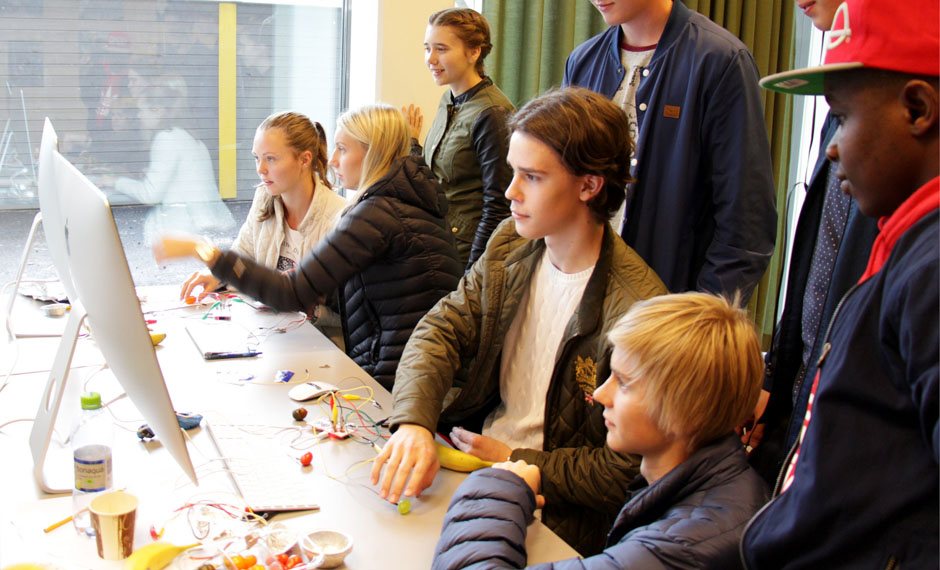
Visitors in Halmstad could climb aboard the Science Safari bus and try their hand at lots of different kinds of experiments.

Borrow a scientist
Many local organisers also invited local schools to “borrow a scientist”, whereby pupils receive a visit from a local researcher who explains about their research, what a researcher does and how to become one as well as answer all the pupils’ questions. The researchers are well briefed prior to their visit and this popular concept was particularly successful with lower secondary school pupils.
Informal discussions with researchers
With an emphasis on creating a relaxed environment in which members of the public can discuss topics of interest with researchers, a number of organisers ran events in cafés, restaurants and bars. Topics offered something for everyone and ranged from child health, education of the future and the climate to urban development, dementia, and work-related stress.
Jönköping ran a comprehensive science café programme throughout the day and at their Science After Work events, people could listen to short presentations from researchers over a drink with musical interludes.
In Eskilstuna, members of the public could fit in a discussion with researchers over breakfast, a soup lunch, or just a coffee and cake. They also ran a virtual science café in the form of a webinar about ways to teach multilingual pupils.
Science cafés held in local cafes around Linköping and Norrköping also proved particularly successful, with interesting discussions on violence in teenage relationships at City Mission’s café in Linköping.

Researchers in Stockholm also challenged visitors to play board games, providing an opportunity for informal discussion.
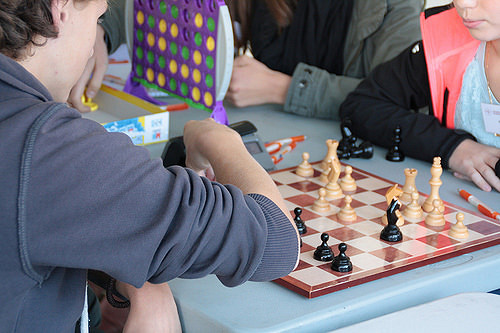
Lectures / talks / debates
In all the cities, there were programmes of talks by researchers on every topic possible, including Hollywood physics, robots, earthquakes, consumer psychology and eye tracking, Nobel Prize winners, ecotourism, high-tech scenography, future energy sources and the demise of the newspaper industry.
The majority allowed the audience to ask questions and even meet the researcher afterwards for informal chats and to try out equipment. Topics that visitors could personally relate to e.g. health, ethics, energy use and the effects of social media also proved popular. In Skellefteå, a talk about the future of driverless cars attracted a new type of audience.
Some organisers ran mini lectures, so the public and school classes could fit in a number of topics. Others provided lectures that linked with some of the work being undertaken by local secondary schools.
Shows
Two cities also put on shows for the general public. Stockholm ran an interactive physics show during which a number of exciting experiments were conducted using 100000 volts and -200 degrees celsius. In Umeå, university lecturers put on a physics and chemistry show.

Competitions
A nation-wide photo competition challenged visitors to capture an image of a researcher at work in order to disprove the stereotypical view of scientists and show that researchers are ordinary people with extraordinary jobs.
Both Stenungsund and Stockholm organised quiz walks whereby visitors had to answer science-related questions along a route.
One main feature of Researchers’ Night was the Researchers’ Grand Prix, a science competition for researchers, who are challenged to present their research to an expert jury and a public audience in just four minutes. Eight cities ran regional heats with communications coaching for the scientists being a key component. Regional winners went on to compete in a national final in Stockholm in November.
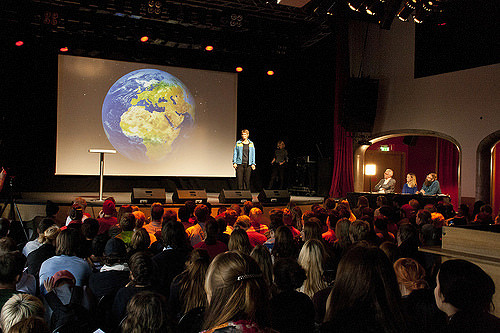
Halmstad and Lund both ran a slightly different version in the form of a science slam, in which researchers presented their research. Lund’s jury and audience consisted of school pupils, who got to evaluate the researchers’ presentations.
Tours and visits
Laboratories and research facilities in a number of cities were open to the public. Once again, the SciLifeLab in Stockholm, a national centre for molecular biosciences with focus on health and environmental research, opened its doors to the public for tours, guided by researchers.
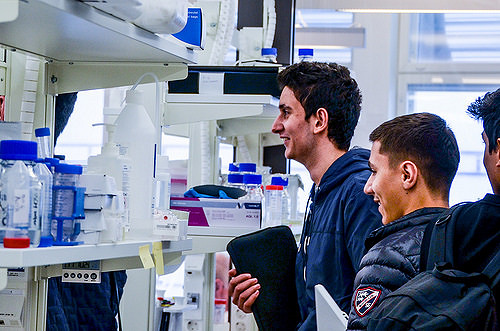
In Östersund, visitors could visit the Swedish Winter Sports Research Centre that to see the facilities used to train and test elite sports professionals. Guided tours were also offered at the Sports Technical Research Centre and its Wind Tunnel Laboratory, which can be used to recreate a range of weather conditions.
Pupils in Borås were invited to explore the Swedish School of Textiles to learn about their research into textiles, including the latest developments in smart textiles and could try their hand at printing and scanning.
Piteå also offered a number of guided bus tours to research institutes around the city. Station Linné, a research institute on the island of Öland, organised an evening bat walk and learn about the fascinating world of bats.
Films
Films with a scientific theme or showcasing research being conducted at universities were used in a number of ways, some running on a continuous loop (e.g. in Lund with films about space) and others accompanied by panel debates (e.g. at the local cinema in Eskilstuna), whereby the audience could discuss issues raised in the film with researchers after the showing.
For further inspiration take a look at our science communications toolbox containing ideas and tips on hundreds of different science communication activities.

